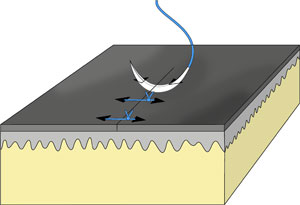Needles Overview
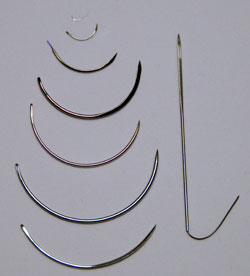
- wide variety of surgical needles available
- considerations when selecting a surgical needle:
- method of suture attachment
- swaged generally preferred
- shape of the needle
- curved generally preferred
- size
- generally the smallest needle that will do the job is selected
- needle point
- taper needles are usually preferred for delicate tissues
- reverse cutting needles are usually selected for skin and tougher tissues
- economics and personal preference
- method of suture attachment
The Basics
- most made of stainless steel
- requirements
- sharp so penetrates tissues easily
- strong so resists bending
- some flexibility so resists breaking
- needle design varies according to:
- method of suture attachment
- shape and amount of curvature
- size of the needle
- design of needle point
Method of suture attachment
Suture material attached to needle in 2 basic ways:
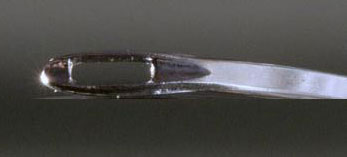
Eyed Needle
Eyed needles:
-
- suture threaded through eye during surgery from inside curve toward outside
- reusable
- economical
- less sharp if reused
- less efficient (time spent threading needle)
- more traumatic (bigger hole because double strand of suture pulled through tissue)
- avoid threading eye twice to prevent suture pulling out as creates more tissue trauma
- mainly used for suturing bovine skin

Swaged Needles
Swaged needles:
-
- suture permanently attached to the needle
- consistently sharp with known shape and durability (not damaged by previous use)
- convenient as threading not required
- more efficient as suture doesn’t pull out while suturing
- generally preferred
Shape and amount of curvature
- shapes vary from straight to curved
- Straight needles
- used near surface (primarily skin)
- inserted through tissues with fingers not needle holders
- usually combined with hand ties
- Curved needles
- manipulated with needle holders
- rotating wrist in arc similar to that of needle is easiest and most efficient
- curvature is described by amount of the circumference of a circle (e.g. 1/4, 3/8, 1/2, 5/8, etc.)
- most common curves are 3/8 and 1/2
- wider curves useful when suturing thick tissues or in deep or poorly accessible locations (easier to retrieve tip)
- most commonly used
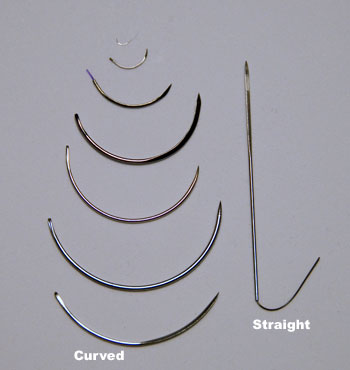
Size of the needle
-
- Needles come in various lengths and diameters
- considerations when selecting needle size:
- tissue to be sutured (larger for thick dense tissue, smaller for delicate tissue)
- size and location of wound
- size of suture material needed to support incision during healing (bigger needle for larger suture)
- selected needle should be
- smallest that will do the job (minimize tissue trauma)
- large enough not to bend during insertion or extraction
- long enough to reach both sides of incision in a single pass
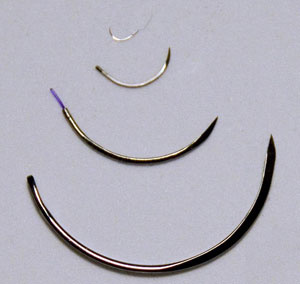
Design of the needle point (tip)
- tip’s design affects its sharpness and how easily it penetrates tissue
- common needle point designs
Taper or non-cutting needles
- have a round body with a sharp pointed tip
- generally used for viscera, muscle and light fascia

- penetrates tissue, without cutting, creating a round hole
- should NOT be used for dense tissue like skin because the extra force needed to penetrate the tissue causes extra trauma or bends the needle
- taper cut tip a newer design that combines the round body with a cutting tip so can be used for both delicate and dense tissue
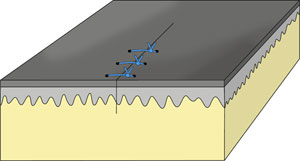
Traditional cutting needle
- triangular shaped point with 2-3 cutting edges to facilitate penetration of dense tissue
- cutting edge is on the inside of the curve (concave surface)

-
- cut edge is where the tension is on the tied suture so this type of needle predisposes the suture to cutting through the tissue
- use has generally been replaced by the reverse cutting needle
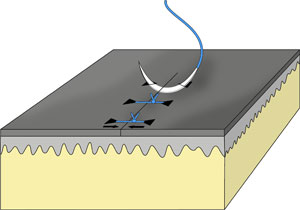
Reverse cutting needle
- cutting edge on outer surface of the curve (convex surface)
- more efficiently uses the cutting surface when curve wrist during insertion

- more resistant to suture cutting through tissue because the cut edge is opposite to the direction of tension on the tied suture
- preferred by most surgeons
